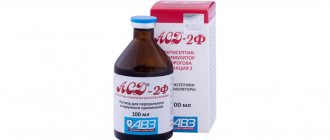Write a review
Reviews: 0
Manufacturers: Laboratoires Servier
Active ingredients
- Agomelatine
Disease class
- Depressive episode
- Recurrent depressive disorder
Clinical and pharmacological group
- Not indicated. See instructions
Pharmacological action
- Antidepressant
Pharmacological group
- Antidepressants
Valdoxan oral tablets
Instructions for medical use of the drug
Description of pharmacological action
Antidepressant; stimulates melatonin (MT1 and MT2) and blocks serotonin (5-HT2C) receptors. Improvement occurs within 2 weeks from the start of therapy.
Indications for use
Treatment of major depressive disorder.
Release form
film-coated tablets 25 mg; contour cell packaging 14, cardboard pack 1; film-coated tablets 25 mg; contour packaging 14 for hospitals, cardboard pack 7; film-coated tablets 25 mg; contour cell packaging 10, cardboard pack 10; film-coated tablets 25 mg; contour cell packaging 14, cardboard pack 1; film-coated tablets 25 mg; contour packaging 14, cardboard pack 2; film-coated tablets 25 mg; contour cell packaging 10, cardboard pack 10; film-coated tablets 25 mg; contour packaging 14, cardboard pack 7;
Pharmacodynamics
Agomelatine is active in validated models of depression (learned helplessness test, despair test, moderate chronic stress), in models with heart rate desynchronization, as well as in experimental situations of anxiety and stress. It has been shown that agomelatine does not affect the uptake of monamines and has no affinity for α-, β-adrenergic receptors, histamine receptors, cholinergic receptors, dopamine and benzodiazepine receptors; This explains the absence of agomelatine’s side effects on the gastrointestinal tract, sexual functions and cardiovascular system, which are characteristic of other antidepressants. Agomelatine, due to its antagonistic effect on serotonin 5-HT2c receptors, enhances the release of dopamine and norepinephrine, especially in the prefrontal cortex. In experimental animal studies with simulated Delayed Sleep Phase Syndrome in blind and aged animals, agomelatine was shown to restore synchronization of circadian rhythms through stimulation of melatonin receptors. In case of chronic stress, agomelatine prevents the occurrence of “broken” (fragmented) sleep. In experiments on healthy volunteers, agomelatine did not disrupt the normal structure of sleep and had a beneficial effect on sleep in patients with depression. In therapeutic doses, agomelatine prevented the development of insomnia and memory impairment from the moment of taking the drug until the morning. Agomelatine is not addictive, as demonstrated in a study of healthy volunteers using a visual analogue scale or the Addiction Research Center Inventory (ARCI 49 check-list). Agomelatine has also been assessed for withdrawal symptoms in depressed patients using the Discontinuation Emergent Signs and Symptoms (DESS) Questionnaire. It has been established that withdrawal syndrome does not develop even with abrupt cessation of treatment. Agomelatine does not affect body weight. Agomelatine's clinical development program examined its efficacy and safety in major depressive disorder. In a placebo comparative controlled study, 4500 patients were examined, of whom 2500 received the drug for 6 weeks to a year. Agomelatine was statistically significantly more effective than placebo, with the antidepressant effect occurring within 2 weeks (efficacy range: 49.1 to 61% versus 34.3 to 46.3% in the placebo group). Reliable data were also obtained on the effectiveness of agomelatine in patients with more severe forms of depressive disorder (Hamilton scale scores ≥25), constituting more than 2/3 of the population. Active control studies confirmed the results. Agomelatine was also effective for initially high levels of anxiety, as well as for combined anxiety and depressive disorders. The effect of agomelatine on the sexual function of patients with depression with a relapsing course of the disease was studied. The Sex Effects Scale (SEXFX) was used. Agomelatine has not been shown to cause sexual dysfunction and does not affect arousal or orgasm. In patients with depression, starting from the second week of treatment, agomelatine statistically significantly improved the process of falling asleep, without causing subsequent daytime lethargy (the Leeds Questionnaire was used).
Pharmacokinetics
Absorption After oral administration, agomelatine is rapidly and well (>80%) absorbed from the gastrointestinal tract. Cmax in plasma is achieved 1–2 hours after administration. Bioavailability at a therapeutic dose taken orally is approximately 3% and varies depending on the first pass effect through the liver and individual differences in CYP1A2 activity parameters. When prescribed in therapeutic doses, the therapeutic concentration of the drug increased in proportion to the dose. Meal intake (both regular and high-fat) did not affect either bioavailability or rate of absorption. Distribution The volume of distribution at equilibrium was about 35 liters. Plasma protein binding is 95%, regardless of drug concentration, age or the presence of renal failure. Metabolism After oral administration, agomelatine undergoes rapid oxidation, mainly due to CYP1A2 (90%) and CYP2C9 (10%). The main metabolites in the form of hydroxylated and demethylated agomelatine are inactive, quickly bind and are excreted in the urine. Removal of T1/2 from plasma is from 1 to 2 hours. Removal occurs quickly. High and mostly metabolic Cl is about 1100 ml/min. Excretion occurs mainly in urine (80%) and in the form of metabolites. The amount of unchanged drug in the urine is insignificant. With repeated administration of the drug, the kinetics do not change. Pharmacokinetics in special clinical cases The dependence of the pharmacokinetics of the drug on age has not been identified. Since no significant changes in pharmacokinetics are observed in patients with renal failure, special selection of drug doses for this category of patients is not required. When comparing the effect of the drug in healthy volunteers (matched for age, body weight and number of cigarettes smoked) with patients with mild (Child-Pugh class A) and moderate (Child-Pugh class B) degrees of liver failure, in the latter an increase in the duration of action of the drug was observed when prescribed at a dose of 25 mg/day. No unusual adverse reactions were observed.
Use during pregnancy
Little experience with the use of agomelatine in pregnant women has not shown any side effects on the course of pregnancy, the health of the fetus or newborn. Currently, there is no other epidemiological information on this matter. During pregnancy, the drug should be used with caution and in cases where the expected benefit of therapy for the mother outweighs the potential risk to the fetus. It is not known whether agomelatine is excreted in human breast milk. If it is necessary to use the drug during lactation, breastfeeding should be discontinued. Experimental studies on animals did not reveal any direct or indirect harmful effects of the drug on pregnancy, embryonic or fetal development, labor or postnatal development. Agomelatine and its metabolites have been shown to be excreted in breast milk in rats.
Contraindications for use
- hypersensitivity to the components of the drug; - severe liver failure.
Side effects
Clinical trials of Valdoxan included more than 4,600 patients. More than 2,400 patients with depression received the drug in doses of 25–50 mg/day. At these doses in short-term placebo-controlled trials, the incidence of side effects was no different from those in the placebo group. Side effects were most often mild or moderate and were observed in the first 2 weeks of treatment. The most commonly observed symptoms were dizziness, nausea, diarrhea, dry mouth, abdominal pain and itching. The incidence of headache in most cases did not differ from that in placebo treatment. Side effects were transient and generally did not require discontinuation of treatment. In short-term, placebo-controlled clinical trials, adverse reactions considered likely to be related to treatment with agomelatine 25–50 mg/day are listed below. The incidence of side effects in patients receiving Valdoxan compared to the placebo group is indicated in parentheses. Determination of the frequency of adverse reactions: very often - >1/10; often - >1/100, 1/1000, 1/10000, From the central nervous system and peripheral nervous system: often - dizziness (5.4% and 3.1%); sometimes - paresthesia (0.9% and 0.1%). From the digestive system: often - nausea (7.7% and 7.1%), dry mouth (3.3% and 3%), diarrhea (2.9% and 2.2%), epigastric pain ( 2.3% and 1.3%); 0.5% - while taking agomelatine at a dose of 25–50 mg/day (and 0.2% in the placebo group), a transient increase in AST was observed 3 times higher than the upper limit of normal. In most cases, these indicators returned to normal without stopping treatment. Dermatological reactions: often - itching (1% and 0.5%); sometimes - dermatitis (0.5% and 0.4%), eczema (0.2% and 0.1%), erythematous rash (0.2% and no reaction). On the part of the visual organs: sometimes - blurred vision (0.6% and no reaction). In double-blind studies using agomelatine for more than 6 months at doses of 25–50 mg/day, the incidence of newly identified side effects did not differ from that compared with placebo. With long-term use of the drug, no new side effects were identified. The type and frequency of adverse reactions did not depend on the gender and age of the patients.
Directions for use and doses
Inside. The recommended dose is 25 mg (1 tablet) 1 time per day in the evening. If necessary, after two weeks of treatment, the dose can be increased to 50 mg (2 tablets) 1 time per day in the evening. According to WHO recommendations, drug therapy for depression should be continued for at least another 6 months after the cessation of the depressive episode. Valdoxan can be taken with or without food. The tablet should be swallowed whole without chewing. If you miss the next dose, during the next dose Valdoxan is taken at the usual dose (the dose of the drug should not be increased). To improve control over taking the drug, a calendar is printed on the blister containing the tablets. For patients with mild to moderate liver failure, the drug is recommended to be prescribed in a daily dose of 25 mg (1 table). Patients with renal failure and elderly patients do not require dose adjustment. To stop treatment there is no need for a gradual dose reduction.
Overdose
Studies on healthy volunteers have shown that when taken orally, agomelatine is well tolerated at doses up to 800 mg/day. Cases of agomelatine overdose are rare. During clinical trials, doses of up to 300 and up to 375 mg/day were reported in combination with other psychotropic drugs. In all of these cases, no signs or symptoms of overdose were reported. Treatment: In case of overdose, specific antidotes for agomelatine are not known. Symptomatic therapy and the usual monitoring for such cases in specialized departments are indicated.
Interactions with other drugs
Potentially possible interaction: 90% of agomelatine is metabolized in the liver with the participation of CYP1A2 isoenzymes and 10% with the participation of CYP2C9/19. Therefore, any drugs whose metabolism depends on these isoenzymes may increase or decrease the bioavailability of agomelatine. Fluvoxamine, which is a strong inhibitor of CYP1A2 and 2C9, may significantly slow down the metabolism of agomelatine (simultaneous use is not recommended). Paroxetine (a CYP1A2 inhibitor) and fluconazole (a strong CYP2C9 inhibitor) do not interfere with the pharmacokinetics of agomelatine. Estrogens, which are moderate inhibitors of CYP1A2, have been shown to enhance the effects of agomelatine. As long as the therapeutic concentration of the drug remains within the normal range of pharmacokinetics, no dose adjustment is required. Smoking increases the effect of CYP1A2, but has been shown to only slightly decrease the duration of action of agomelatine. Therefore, smokers do not need to adjust their dose. Possibility of action of agomelatine on other drugs Agomelatine does not induce or inhibit CYP450 isoenzymes and therefore does not affect the action of drugs whose metabolism is associated with these isoenzymes. In healthy volunteers, agomelatine did not change the pharmacokinetics of theophylline (CYP1A2). Agomelatine does not change the free concentration of drugs that are significantly bound to plasma proteins and, in turn, do not affect the concentration of agomelatine. There is no pharmacokinetic or pharmacodynamic interaction between lorazepam and agomelatine. There is no pharmacokinetic or pharmacodynamic interaction between lithium preparations and agomelatine. There are no data on the use of agomelatine concomitantly with electroconvulsive therapy. Since agomelatine did not show seizure-predisposing properties in animal experiments, undesirable effects of electroconvulsive therapy when used together seem unlikely.
Special instructions for use
The simultaneous use of Valdoxan with fluvoxamine, which is a strong inhibitor of CYP1A2 and 2C9 and can significantly slow down the metabolism of agomelatine, is not recommended. As with other antidepressants, agomelatine should be used with caution in patients with a history of manic or hypomanic episodes and discontinue the medication if the patient develops symptoms of mania. Agomelatine does not increase the risk of suicide. But since with depression there is always a risk of suicide, which can occur periodically until stable remission is achieved, very careful monitoring of patients is required at the beginning of treatment. With mild (Child-Pugh class A) and moderate (Child-Pugh class B) degrees of liver failure, an increase in drug exposure was observed. Since the excipients of Valdoxan tablets include lactose, it should not be used in patients suffering from lactose intolerance, either in the congenital form of intolerance or in cases of Lapp lactase deficiency or glucose-galactose malabsorption. As with treatment with other antidepressants, it is not recommended to combine Valdoxan with alcohol. Use in pediatrics The use of the drug in children and adolescents under 18 years of age is not recommended due to the lack of sufficient clinical data.
Storage conditions
List B: No special storage conditions are required.
Best before date
36 months
ATX classification:
N Nervous system
N06 Psychoanaleptics
N06A Antidepressants
N06AX Other antidepressants
N06AX22 Agomelatine
Similar drugs:
- Miaser Oral tablets
- Life 900 (LIFE 900) Oral tablets
- Heptral Lyophilisate for the preparation of a solution for intramuscular, subconjunctival administration and for instillation into the eye
- Lenuksin Oral tablets
- Heptor (Heptor) Lyophilisate for the preparation of solution for injection
- Prodep Capsule
- Citalopram Oral tablets
- Paroxetine Oral tablets
- Spitomin Tablets
- Deprim forte Capsule
** The Drug Directory is intended for informational purposes only. For more complete information, please refer to the manufacturer's instructions. Do not self-medicate; Before you start using Valdoxan, you should consult a doctor. EUROLAB is not responsible for the consequences caused by the use of information posted on the portal. Any information on the site does not replace medical advice and cannot serve as a guarantee of the positive effect of the drug.
Are you interested in the drug Valdoxan? Do you want to know more detailed information or do you need a doctor's examination? Or do you need an inspection? You can make an appointment with a doctor - the Euro lab is always at your service! The best doctors will examine you, advise you, provide the necessary assistance and make a diagnosis. You can also call a doctor at home . Euro lab clinic is open for you around the clock.
** Attention! The information presented in this medication guide is intended for medical professionals and should not be used as a basis for self-medication. The description of the drug Valdoxan is provided for informational purposes and is not intended for prescribing treatment without the participation of a doctor. Patients need to consult a specialist!
If you are interested in any other drugs and medications, their descriptions and instructions for use, information about the composition and form of release, indications for use and side effects, methods of use, prices and reviews of drugs, or you have any other questions and suggestions - write to us, we will definitely try to help you.
Valdoxan price, where to buy
This drug can be bought in Moscow, in almost any pharmacy. At the same time, the price of Valdoxan varies from 1670 to 2060 rubles.
- Online pharmacies in RussiaRussia
- Online pharmacies in KazakhstanKazakhstan
ZdravCity
- Valdoxan tablets p.p.o.
25 mg 28 pcs. LLC Servier Rus 1434 rub. order
Pharmacy Dialogue
- Valdoxan tablets 25 mg No. 28Servier
RUB 1,378 order
- Valdoxan tablets 25 mg No. 28 Serdix LLC
RUB 1,466 order
show more


